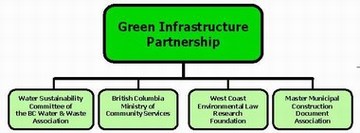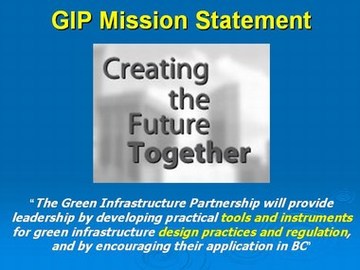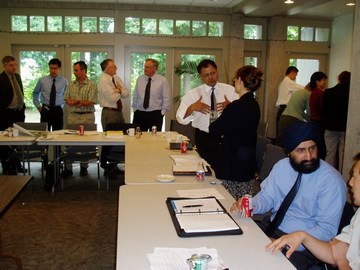Green Infrastructure Partnership
The Green Infrastructure Partnership (GIP) is one of six inter-connected initiatives that comprise the Water Sustainability Action Plan for British Columbia. The Action Plan provides a partnership umbrella for on-the-ground initiatives that are informing Provincial policy through shared responsibility. The Action Plan is also enabling the Province to collaborate with local government to advance water stewardship and sustainable communities.

The Green Infrastructure Partnership was formed in 2003, and is a consortium of four organizations, namely:
- British Columbia Ministry of Community Services (MCS)
- Water Sustainability Committee of the British Columbia Water & Waste Association (WSC)
- West Coast Environmental Law Research Foundation (WCEL)
- Master Municipal Construction Documents Association (MMCD)
The four organizations share a vision of making green infrastructure practices more prevalent in communities across British Columbia. An integral part of the process is to create a picture of what the future landscape can look like. If we agree on where we wish to be in one or two generations, then we can map out the route to get there.

The Green Infrastructure Partnership is promoting an integrated approach to land development that addresses the need for coordinated change in policies, programs and practices at different scales – that is: region, neighbourhood, site and building.
Implementation by local governments will be voluntary – involving a range of social and economic considerations – but once the decision is made to embrace green infrastructure, implementation will need clearly defined standards and regulatory models.
CONSULTATION WORKSHOPS: Consultation Workshops in May 2004 and May 2005 have resulted in successive reconfigurations of the Green Infrastructure Partnership’s work plan, with the emphasis now on educating stakeholders regarding the benefits of a design with nature approach to community planning and land development, and facilitating adoption of this approach. This means build and/or rebuild communities in harmony with the natural environment.

To download the reference document titled The Green Infrastructure Partnership: Convening for Action in British Columbia (July 2005 Progress Report), click here. The Executive Summary is reproduced below.
The Progress Report provides a record of how consultation workshops are shaping the work plan of the GIP, and identifies next steps. Key messages in the report are distilled as follows to provide a seamless storyline:
Section 1 – Creating our Future: In planning for the next 50 years and beyond, the vision is one of greener communities that will achieve higher levels of ecological and stream protection. Achieving this outcome will require changes to existing land use regulations, design guidelines and construction standards.
Section 2 – Design with Nature: To both accommodate population growth and achieve a community vision for sustainability and liveability, the Green Infrastructure Partnership is encouraging implementation of a design with nature approach to community planning and land (re)development.
Section 3 – Turning Ideas Into Action: Reaching the critical mass necessary to achieve the design with nature vision requires a series of transformational events that will be the catalyst for comprehensive partnership action that creates a legacy. The desired outcome in ‘convening for action’ is on-the-ground changes in the way we develop land and manage water.
Sections 4 and 5 – Roundtable Sharing: The Green Infrastructure Partnership convened Consultation Workshops in 2004 and 2005 in order to:
- Obtain feedback/input.
- Generate enthusiasm.
- Obtain tangible commitments of support.
The 2004 workshop was practitioner oriented. Participants stressed the need for systems-based thinking and an integrated approach to planning, zoning and infrastructure design. They also stressed that green infrastructure was more than tinkering with the ways things are currently done.
The 2005 workshop involved local government. The atmosphere was upbeat with participants enthusiasticaly stressing that the number of success stories is growing. There are hurdles to overcome, but they are not insurmountable. The clear message was to make outreach and practitioner education the #1 priority.
Section 6 – An Integrated Work Plan: Partnership initiatives that are already underway as part of the Water Sustainability Action Plan will enable the Green Infrastructure Partnership to move forward with implementation of a multi-pronged Outreach & Continuing Education Program (OCEP), efficiently and effectively.
Section 7 – Benefits in Pooling Resources: Willing municipalities will be asked to assign staff to pool resources under a partnership framework. This will result in the following benefits:
- Builds relatonships.
- Municipalities can leverage the efforts of their own staffs.
- Cross-fertilization of case study experience.
- Common understanding of issues and solutions.
- Consistent messaging region-wide

FRAMEWORK FOR OUTREACH & CONTINUING EDUCATION PROGRAM: Benefits will flow from the Green Infrastructure Partnership (GIP) delivering added value through an Outreach and Continuing Education Program (OCEP) that will enable the GIP to be an effective facilitator. The graphic below illustrates the ten educational elements that comprise OCEP. For background on how OCEP evolved through a consultation process that tapped the wisdom and experience of local governments and pioneer practitioners, click on this link.

WEB DELIVERY: Web delivery is a core element of an information transfer strategy for promoting on-the-ground changes in policies, programs, practices and practitioner education. For this reason, the communication needs of the Green Infrastructure Partnership (GIP) are being met through the waterbucket.ca website. Grants from the Ministry of Environment (MOE) have enabled the Water Sustainability Committee and the Green Infrastructure Partnership to create the structure and content placeholders for the Green Infrastructure Community-of-Interest. The MOE contribution was provided under the umbrella of the Convening for Action initiative.

